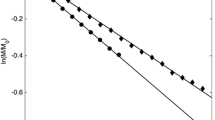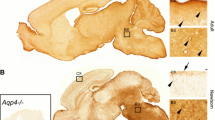Abstract
Aquaporin-4 (AQP4) is the predominant water channel in the brain and is expressed in high density in astrocytes. By fluxing water along osmotic gradients, AQP4 contributes to brain volume and ion homeostasis. Here we ask whether deletion of Aqp4 leads to upregulation of the gap junctional proteins connexin-43 (Cx43) and connexin-30 (Cx30). These molecules couple adjacent astrocytes to each other and allow water and ions to redistribute within the astrocyte syncytium. Immunogold analysis of parietal cortex and hippocampus showed that the number of gap junctions per capillary profile is increased in AQP4 knockout (AQP4 KO) mice. The most pronounced changes were observed for Cx43 in hippocampus where the number of connexin labeled gap junctions increased by 100% following AQP4 KO. Western blot analysis of whole tissue homogenates showed no change in the amount of Cx43 or Cx30 protein after AQP4 KO. However, AQP4 KO led to a significant increase in the amount of Cx43 in a Triton X-100 insoluble fraction. This fraction is associated with connexin assembly into gap junctional plaques in the plasma membrane. In line with our immunoblot data, RT-qPCR showed no significant increase in Cx43 and Cx30 mRNA levels after AQP4 KO. Our findings suggest that AQP4 KO leads to increased aggregation of Cx43 into gap junctions and provide a putative mechanistic basis for the enhanced tracer coupling in hippocampi of AQP4 KO mice. The increased number of gap junctions in AQP4 deficient mice may explain why Aqp4 deletion has rather modest effects on brain volume and K+ homeostasis.








Similar content being viewed by others
References
Aberg ND, Carlsson B, Rosengren L, Oscarsson J, Isaksson OG, Ronnback L, Eriksson PS (2000) Growth hormone increases connexin-43 expression in the cerebral cortex and hypothalamus. Endocrinology 141:3879–3886. doi:10.1210/endo.141.10.7731
Amiry-Moghaddam M et al (2003a) An alpha-syntrophin-dependent pool of AQP4 in astroglial end-feet confers bidirectional water flow between blood and brain. Proc Natl Acad Sci USA 100:2106–2111. doi:10.1073/pnas.0437946100
Amiry-Moghaddam M et al (2003b) Delayed K+ clearance associated with aquaporin-4 mislocalization: phenotypic defects in brains of alpha-syntrophin-null mice. Proc Natl Acad Sci USA 100:13615–13620. doi:10.1073/pnas.2336064100
Amiry-Moghaddam M et al (2005) Brain mitochondria contain aquaporin water channels: evidence for the expression of a short AQP9 isoform in the inner mitochondrial membrane. FASEB J Off Publ Feder Am Soc Exp Biol 19:1459–1467. doi:10.1096/fj.04-3515com
Ball KK, Harik L, Gandhi GK, Cruz NF, Dienel GA (2011) Reduced gap junctional communication among astrocytes in experimental diabetes: contributions of altered connexin protein levels and oxidative-nitrosative modifications. J Neurosci Res 89:2052–2067. doi:10.1002/jnr.22663
Bellot-Saez A, Kekesi O, Morley JW, Buskila Y (2017) Astrocytic modulation of neuronal excitability through K+ spatial buffering. Neurosci Biobehav Rev 77:87–97. doi:10.1016/j.neubiorev.2017.03.002
Binder DK, Yao X, Verkman AS, Manley GT (2006) Increased seizure duration in mice lacking aquaporin-4 water channels. Acta Neurochir Suppl 96:389–392
Cooper CD, Lampe PD (2002) Casein kinase 1 regulates connexin-43 gap junction assembly. J Biol Chem 277:44962–44968. doi:10.1074/jbc.M209427200
Ezan P et al (2012) Deletion of astroglial connexins weakens the blood–brain barrier. J Cereb Blood Flow Metab Off J Int Soc Cereb Blood Flow Metab 32:1457–1467. doi:10.1038/jcbfm.2012.45
Griemsmann S et al (2015) Characterization of panglial gap junction networks in the thalamus, neocortex, and hippocampus reveals a unique population of glial cells. Cereb Cortex 25:3420–3433. doi:10.1093/cercor/bhu157
Haas B, Schipke CG, Peters O, Sohl G, Willecke K, Kettenmann H (2006) Activity-dependent ATP-waves in the mouse neocortex are independent from astrocytic calcium waves. Cereb cortex 16:237–246. doi:10.1093/cercor/bhi101
Haj-Yasein NN, Bugge CE, Jensen V, Ostby I, Ottersen OP, Hvalby O, Nagelhus EA (2015) Deletion of aquaporin-4 increases extracellular K concentration during synaptic stimulation in mouse hippocampus. Brain Struct Funct 220(4):2469–74 doi:10.1007/s00429-014-0767-z
Hofer A, Dermietzel R (1998) Visualization and functional blocking of gap junction hemichannels (connexons) with antibodies against external loop domains in astrocytes. Glia 24:141–154
Iliff JJ et al (2012) A paravascular pathway facilitates CSF flow through the brain parenchyma and the clearance of interstitial solutes, including amyloid beta. Sci Transl Med 4:147ra111. doi:10.1126/scitranslmed.3003748
Khan D, Dupper A, Deshpande T, De Graan PNE, Steinhauser C, Bedner P (2016) Experimental febrile seizures impair interastrocytic gap junction coupling in juvenile mice. J Neurosci Res 94:804–813. doi:10.1002/jnr.23726
Lee TS, Eid T, Mane S, Kim JH, Spencer DD, Ottersen OP, de Lanerolle NC (2004) Aquaporin-4 is increased in the sclerotic hippocampus in human temporal lobe epilepsy. Acta Neuropathol 108:493–502
Li J, Verkman AS (2001) Impaired hearing in mice lacking aquaporin-4 water channels. J Biol Chem 276:31233–31237. doi:10.1074/jbc.M104368200
Lu DC, Zhang H, Zador Z, Verkman AS (2008) Impaired olfaction in mice lacking aquaporin-4 water channels. FASEB J Off Publ Feder Am Soc Exp Biol 22:3216–3223. doi:10.1096/fj.07-104836
Lunde LK, Camassa LM, Hoddevik EH, Khan FH, Ottersen OP, Boldt HB, Amiry-Moghaddam M (2015) Postnatal development of the molecular complex underlying astrocyte polarization. Brain Struct Funct 220(4):2087–101 doi:10.1007/s00429-014-0775-z
Manley GT et al (2000) Aquaporin-4 deletion in mice reduces brain edema after acute water intoxication and ischemic stroke. Nat Med 6:159–163. doi:10.1038/72256
Musil LS, Goodenough DA (1991) Biochemical-analysis of connexin43 intracellular-transport, phosphorylation, and assembly into gap junctional plaques. J Cell Biol 115:1357–1374. doi:10.1083/jcb.115.5.1357
Musil LS, Cunningham BA, Edelman GM, Goodenough DA (1990) Differential phosphorylation of the gap junction protein connexin43 in junctional communication-competent and -deficient cell lines. J Cell Biol 111:2077–2088
Mylonakou MN et al (2009) Analysis of mice with targeted deletion of AQP9 gene provides conclusive evidence for expression of AQP9 in neurons. J Neurosci Res 87:1310–1322. doi:10.1002/jnr.21952
Nagelhus EA, Ottersen OP (2013) Physiological roles of aquaporin-4 in brain. Physiol Rev 93:1543–1562. doi:10.1152/physrev.00011.2013
Nagy JI, Rash JE (2000) Connexins and gap junctions of astrocytes and oligodendrocytes in the CNS. Brain Res Brain Res Rev 32:29–44
Nagy JI, Yamamoto T, Sawchuk MA, Nance DM, Hertzberg EL (1992) Quantitative immunohistochemical and biochemical correlates of connexin43 localization in rat brain. Glia 5:1–9. doi:10.1002/glia.440050102
Nagy JI, Patel D, Ochalski PAY, Stelmack GL (1999) Connexin30 in rodent, cat and human brain: selective expression in gray matter astrocytes, co-localization with connexin43 at gap junctions and late developmental appearance. Neuroscience 88:447–468. doi:10.1016/S0306-4522(98)00191-2
Nielsen S, Nagelhus EA, Amiry-Moghaddam M, Bourque C, Agre P, Ottersen OP (1997) Specialized membrane domains for water transport in glial cells: high-resolution immunogold cytochemistry of aquaporin-4 in rat brain. J Neurosci 17:171–180
Niermann H, Amiry-Moghaddam M, Holthoff K, Witte OW, Ottersen OP (2001) A novel role of vasopressin in the brain: modulation of activity-dependent water flux in the neocortex. J Neurosci 21:3045–3051
Nowak MA, Boerlijst MC, Cooke J, Smith JM (1997) Evolution of genetic redundancy. Nature 388:167–171. doi:10.1038/40618
Papadopoulos MC, Verkman AS (2013) Aquaporin water channels in the nervous system. Nature Rev Neurosci 14:265–277. doi:10.1038/nrn3468
Papadopoulos MC, Manley GT, Krishna S, Verkman AS (2004) Aquaporin-4 facilitates reabsorption of excess fluid in vasogenic brain edema. FASEB J Off Publ Feder Am Soc Exp Biol 18:1291–1293. doi:10.1096/fj.04-1723fje
Promeneur D, Lunde LK, Amiry-Moghaddam M, Agre P (2013) Protective role of brain water channel AQP4 in murine cerebral malaria. Proc Natl Acad Sci USA 110:1035–1040. doi:10.1073/pnas.1220566110
Quist AP, Rhee SK, Lin H, Lal R (2000) Physiological role of gap-junctional hemichannels: extracellular calcium-dependent isosmotic volume regulation. J Cell Biol 148:1063–1074. doi:10.1083/jcb.148.5.1063
Rash JE, Yasumura T, Hudson CS, Agre P, Nielsen S (1998) Direct immunogold labeling of aquaporin-4 in square arrays of astrocyte and ependymocyte plasma membranes in rat brain and spinal cord. Proc Natl Acad Sci USA 95:11981–11986
Rash JE, Yasumura T, Dudek FE, Nagy JI (2001) Cell-specific expression of connexins and evidence of restricted gap junctional coupling between glial cells and between neurons. J Neurosci 21:1983–2000
Rouach N, Koulakoff A, Abudara V, Willecke K, Giaume C (2008) Astroglial metabolic networks sustain hippocampal synaptic transmission. Science 322:1551–1555. doi:10.1126/science.1164022
Solan JL, Lampe PD (2009) Connexin43 phosphorylation: structural changes and biological effects. Biochem J 419:261–272. doi:10.1042/Bj20082319
Solan JL, Fry MD, TenBroek EM, Lampe PD (2003) Connexin43 phosphorylation at S368 is acute during S and G2/M and in response to protein kinase C activation. J Cell Sci 116:2203–2211
Strohschein S, Huttmann K, Gabriel S, Binder DK, Heinemann U, Steinhauser C (2011) Impact of aquaporin-4 channels on K+ buffering and gap junction coupling in the hippocampus. Glia 59:973–980. doi:10.1002/glia.21169
Takumi Y et al (1998) Select types of supporting cell in the inner ear express aquaporin-4 water channel protein. Eur J Neurosci 10:3584–3595
Thrane AS et al (2011) Critical role of aquaporin-4 (AQP4) in astrocytic Ca2+ signaling events elicited by cerebral edema. Proc Natl Acad Sci USA 108:846–851. doi:10.1073/pnas.1015217108
Verbavatz JM, Ma T, Gobin R, Verkman AS (1997) Absence of orthogonal arrays in kidney, brain and muscle from transgenic knockout mice lacking water channel aquaporin-4. J Cell Sci 110(Pt 22):2855–2860
Verkman AS, Binder DK, Bloch O, Auguste K, Papadopoulos MC (2006) Three distinct roles of aquaporin-4 in brain function revealed by knockout mice. Biochem Biophys Acta 1758:1085–1093. doi:10.1016/j.bbamem.2006.02.018
Yang B, Brown D, Verkman AS (1996) The mercurial insensitive water channel (AQP-4) forms orthogonal arrays in stably transfected Chinese hamster ovary cells. J Biol Chem 271:4577–4580
Yang J et al (2011) Loss of astrocyte polarization in the tg-ArcSwe mouse model of Alzheimer’s disease. J Alzheimers Dis 27:711–722. doi:10.3233/JAD-2011-110725
Acknowledgements
The authors are grateful to Ms.Bjørg Riber, Karen Marie Gujord and Jorunn Knutsen for the technical assistance and Carina Knudsen for the help with the artwork. Cx30−/−Cx43fl/fl/hGFAP-Cre mice were a kind gift from Dr. Martine Cohen Salmon, École des Neurosciences de Paris Île-de-France (ENP).
Author information
Authors and Affiliations
Corresponding author
Ethics declarations
Ethical approval
All procedures performed in this study involving animals were in accordance with the ethical standards of the institution or practice at which the studies were conducted.
Rights and permissions
About this article
Cite this article
Katoozi, S., Skauli, N., Rahmani, S. et al. Targeted deletion of Aqp4 promotes the formation of astrocytic gap junctions. Brain Struct Funct 222, 3959–3972 (2017). https://doi.org/10.1007/s00429-017-1448-5
Received:
Accepted:
Published:
Issue Date:
DOI: https://doi.org/10.1007/s00429-017-1448-5




